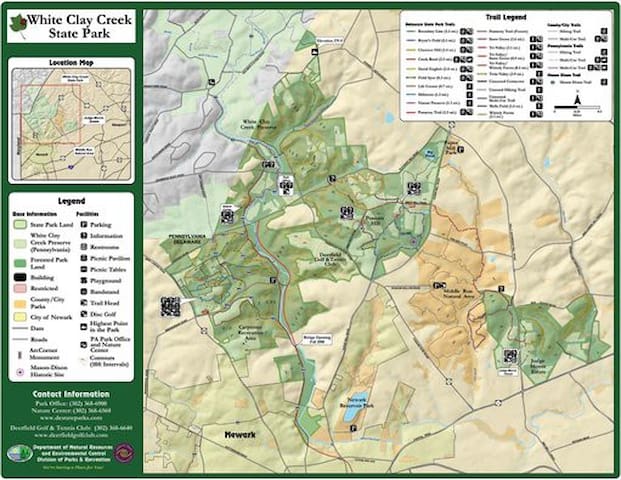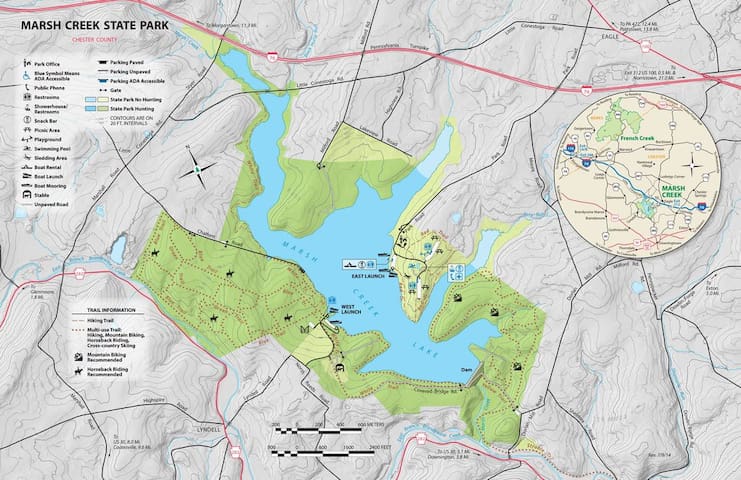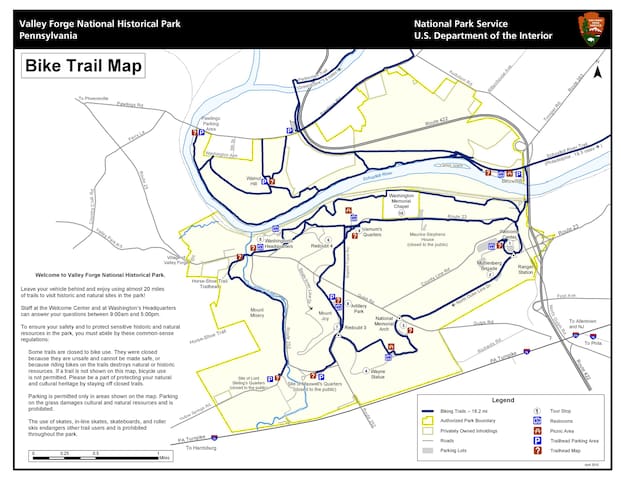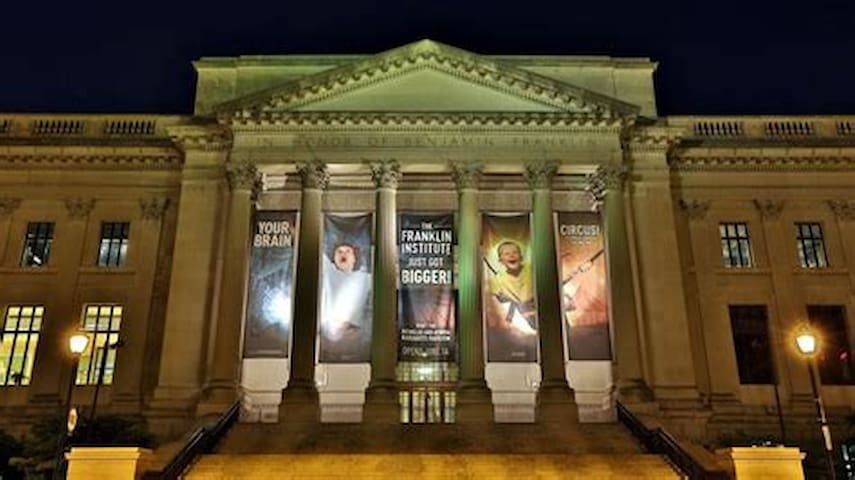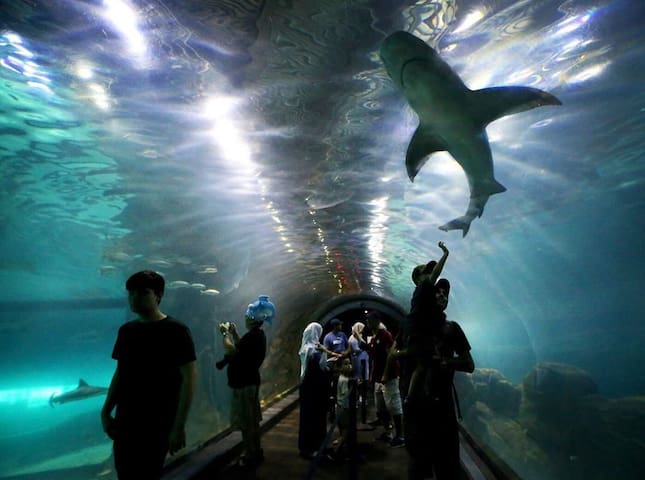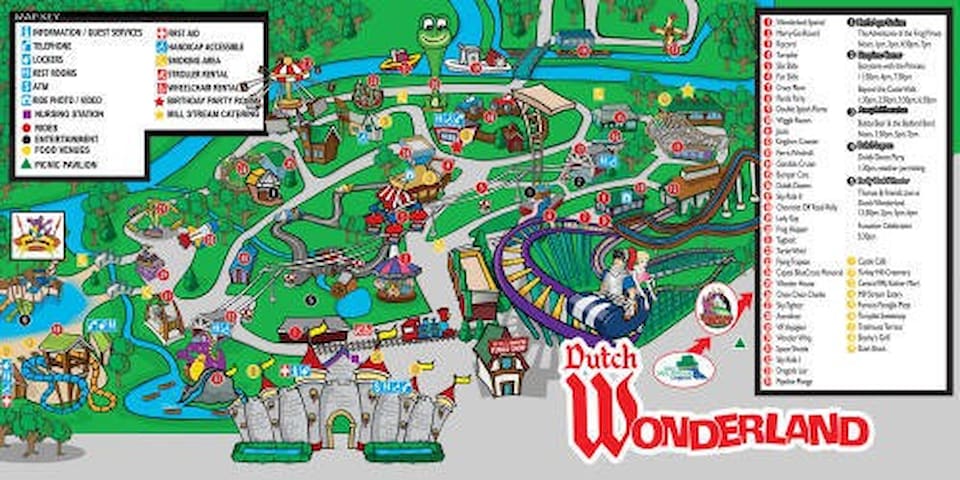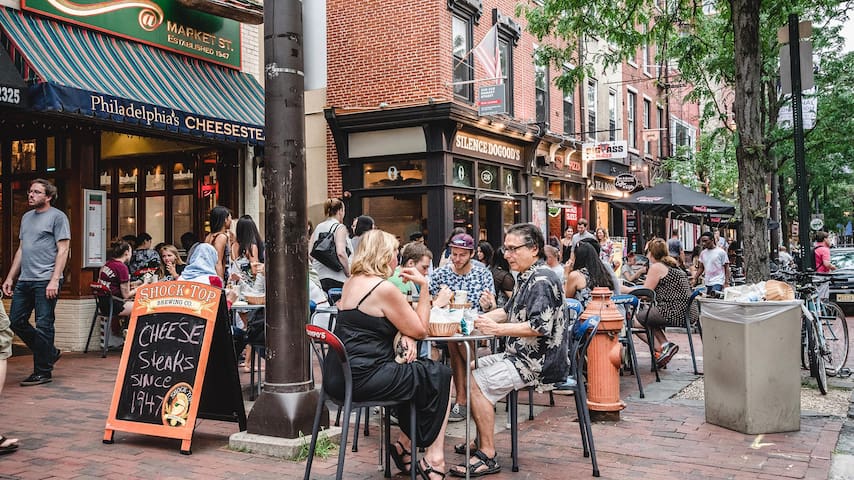Sightseeing
Family friendly day trips or romantic walks in the park.
The 2,072-acre White Clay Creek Preserve is in southern Chester County, three miles north of Newark, Delaware. The White Clay Creek Valley, which forms the core of the preserve, varies from steep to gradually falling terrain with some flat bottomlands, all drained by the creek. White Clay Creek Preserve shares boundary with White Clay Creek State Park of Delaware.
Because White Clay Creek posses outstanding scenic, wildlife, recreational, and cultural value, it has been designated by Congress as a National Wild and Scenic River, and shall be preserved in free-flowing condition for the benefit and enjoyment of present and future generations.
White Clay Creek Preserve
404 Sharpless RdThe 2,072-acre White Clay Creek Preserve is in southern Chester County, three miles north of Newark, Delaware. The White Clay Creek Valley, which forms the core of the preserve, varies from steep to gradually falling terrain with some flat bottomlands, all drained by the creek. White Clay Creek Preserve shares boundary with White Clay Creek State Park of Delaware.
Because White Clay Creek posses outstanding scenic, wildlife, recreational, and cultural value, it has been designated by Congress as a National Wild and Scenic River, and shall be preserved in free-flowing condition for the benefit and enjoyment of present and future generations.
Marsh Creek State Park is in the rolling hills of north central Chester County. The 1,727-acre park contains the 535-acre Marsh Creek Lake, which is a wonderful resource for fishing, sailing, and migrating waterfowl.
Marsh Creek State Park was developed to help manage the water resources in the Brandywine Creek Watershed. Frequent flooding, water shortages, and lack of recreational opportunities were problems in the watershed.
The park was formerly a combination of rolling, wooded hills and small farms located on both sides of the Marsh Creek valley. The former village of Milford Mills is now under 30 to 50 feet of water. All of the buildings were removed; leaving only a few roads, foundations, and the embankments to the Larkin’s Bridge under the lake.
The lake was created by the damming of Marsh Creek. Construction of the dam occurred between May 1970 and June 1973. The impoundment is a 90-foot-high, 990-foot-long earth and rock fill dam on Marsh Creek, a tributary of the East Branch of Brandywine Creek.
On November 16, 1973, the gates of the dam were closed. The lake reached normal pool stage 218 days later on June 21, 1974.
At normal pool elevation of 359.5 feet above sea level, the impoundment covers an area of 535 acres plus a 25-acre wetland. The lake volume is 13,000 acre-feet (4.4 billion gallons) with a maximum depth of 80 feet at the dam.
25 locals raden deze aan
Marsh Creek State Park
675 Park RdMarsh Creek State Park is in the rolling hills of north central Chester County. The 1,727-acre park contains the 535-acre Marsh Creek Lake, which is a wonderful resource for fishing, sailing, and migrating waterfowl.
Marsh Creek State Park was developed to help manage the water resources in the Brandywine Creek Watershed. Frequent flooding, water shortages, and lack of recreational opportunities were problems in the watershed.
The park was formerly a combination of rolling, wooded hills and small farms located on both sides of the Marsh Creek valley. The former village of Milford Mills is now under 30 to 50 feet of water. All of the buildings were removed; leaving only a few roads, foundations, and the embankments to the Larkin’s Bridge under the lake.
The lake was created by the damming of Marsh Creek. Construction of the dam occurred between May 1970 and June 1973. The impoundment is a 90-foot-high, 990-foot-long earth and rock fill dam on Marsh Creek, a tributary of the East Branch of Brandywine Creek.
On November 16, 1973, the gates of the dam were closed. The lake reached normal pool stage 218 days later on June 21, 1974.
At normal pool elevation of 359.5 feet above sea level, the impoundment covers an area of 535 acres plus a 25-acre wetland. The lake volume is 13,000 acre-feet (4.4 billion gallons) with a maximum depth of 80 feet at the dam.
Valley Forge is a name that every child learns in elementary school, but most people still don't know the story of what happened. Valley Forge National Historical Park was created to preserve our nation's history and tell the story of the Continental Army during the winter of 1777-78.
Through the years, the park has grown to be much more than historic site.
On December 14, 2018 the National Park Service opened a new 5,760 square-foot Visitor Center within Valley Forge National Historical Park. The opening of this new, temporary facility will enable construction to begin on a $12 million renovationOpens a New Window. to the current Visitor Center (built 1976). Visitor services, including The Encampment Store, the Valley Forge Tourism & Convention Board information desk, public tours and the park orientation film will continue uninterrupted in the new Visitor Center. The new Visitor Center is located 800 feet from the current Visitor Center (1976).
Valley Forge National Historical Park is a true group destination. The park is popular with groups of all ages, from elementary school field trips and scout troop outings to motorcoach tours.
https://www.valleyforge.org/
Valley Forge Park
Valley Forge ParkValley Forge is a name that every child learns in elementary school, but most people still don't know the story of what happened. Valley Forge National Historical Park was created to preserve our nation's history and tell the story of the Continental Army during the winter of 1777-78.
Through the years, the park has grown to be much more than historic site.
On December 14, 2018 the National Park Service opened a new 5,760 square-foot Visitor Center within Valley Forge National Historical Park. The opening of this new, temporary facility will enable construction to begin on a $12 million renovationOpens a New Window. to the current Visitor Center (built 1976). Visitor services, including The Encampment Store, the Valley Forge Tourism & Convention Board information desk, public tours and the park orientation film will continue uninterrupted in the new Visitor Center. The new Visitor Center is located 800 feet from the current Visitor Center (1976).
Valley Forge National Historical Park is a true group destination. The park is popular with groups of all ages, from elementary school field trips and scout troop outings to motorcoach tours.
https://www.valleyforge.org/
MISSION & HISTORY
Founded in honor of America’s first scientist, Benjamin Franklin, The Franklin Institute is one of the oldest and premier centers of science education and development in the country. Today, the Institute continues its dedication to public education and creating a passion for science by offering new and exciting access to science and technology in ways that would dazzle and delight its namesake.
The Franklin Institute's Mission
In the spirit of inquiry and discovery embodied by Benjamin Franklin, the mission of The Franklin Institute is to inspire a passion for learning about science and technology.
About The Franklin Institute
As the most visited museum in the Commonwealth of Pennsylvania and a top-five tourist destination in the City of Philadelphia, The Franklin Institute is one of the leading science centers in the country, and serves as both a prominent educational and cultural resource, and as an anchor of the local economy. Science and technology have the potential to solve some of the most critical issues of our time, to improve our lives, and to inspire our curiosity about the world around us. Every day The Franklin Institute provides resources that help people to connect with science and technology in creative ways that resonate with learners of all ages and backgrounds. The Institute directly reaches more than 1 million people each year with informal learning experiences that engage students, adults, and families. Though its historic museum is a central learning space, the Institute has evolved to provide people with educational resources in their own neighborhoods through hands-on activities in classrooms, workshops in libraries, community centers, and other settings, and through ways to interact online. Since 1824, The Franklin Institute has pursued its commitment to making these resources available to as many people as possible throughout the mid-Atlantic region.
History
On February 5, 1824, Samuel Vaughan Merrick and William H. Keating founded The Franklin Institute of the State of Pennsylvania for the Promotion of the Mechanic Arts. Within three years of its founding, that promotion took place through public lectures, a high school, a library, public exhibitions, and a research journal, and many of these endeavors remain core activities to this day. Since then The Franklin Institute has played a central, yet constantly evolving, role in meeting the educational needs of America in the fields of science and technology. For the organization's first century, the Institute offered classes in mechanics, drafting, and engineering, and promoted science and invention. In 1930, despite the Great Depression, The Franklin Institute and the Poor Richard Club began to seek funds to build a new science museum and memorial hall. In just twelve days, the community contributed $5.1 million, and in 1932, the cornerstone of the new Franklin Institute was laid at 20th Street and the Benjamin Franklin Parkway.
The Franklin Institute science museum opened to the public on January 1, 1934, titling itself a "Wonderland of Science," and was one of the first museums in the nation to offer a hands-on approach to learning about the physical world. Three major capital campaigns (1990, 2003, and 2012) enabled physical and programmatic expansion resulting in the existing facility, which contains more than 400,000 square feet of exhibit space, two auditoriums, and the Tuttleman IMAX Theater. The Institute also operates the Fels Planetarium, the second oldest planetarium in the Western Hemisphere. The Institute is home to the Benjamin Franklin National Memorial, which was fully restored in 2010 and which is open free to the public. It is one of just a handful of national memorials in the custody of a private institution.
In June 2014 the Institute opened a new wing: the 53,000-square-foot Nicholas and Athena Karabots Pavilion houses a STEM education and conference center, a climate-controlled traveling exhibition gallery, and the new permanent exhibit Your Brain, in which visitors can explore neuroscience and their own senses. The new building is LEED-Silver certified thanks to its many energy-saving and “green” features, and has received an award from the American Institute of Architects.
Today, the Institute offers 12 world-class permanent exhibits that provide hands-on learning experiences that introduce and reinforce key science concepts in creative and engaging ways. The Institute also hosts renowned traveling exhibits that draw local, national, and international visitors to the museum, such as King Tut, the most visited museum exhibit in the world in 2007, and Body Worlds in 2010. As an American Association of Museums-accredited organization, the Institute holds curatorial collections—particularly those related to Benjamin Franklin and the Wright Brothers—that are considered national treasures.
At nearly 200 years old, The Franklin Institute Awards program is America's oldest and most prestigious recognition of achievement in science, technology, and industry. The Institute’s annual presentation of the Benjamin Franklin Medals in seven fields of science and engineering, the Bower Award and Prize for Achievement in Science, and the Bower Award for Business Leadership provides public recognition and encouragement of excellence in science and technologyand celebrates the legacy of our namesake, Benjamin Franklin.The list of Franklin Institute laureates reads like a "Who's Who" in the history of science and technology, virtually charting their advancement through the past two centuries—from the development of the typewriter to the dawn of quantum computing. The honor roll of more than 2,000 Franklin Institute Awards laureates includes Nikola Tesla, Marie and Pierre Curie, Rudolf Diesel, Orville Wright, Thomas Edison, Max Planck, Albert Einstein, Frank Lloyd Wright, Stephen Hawking, Gordon Moore, Jane Goodall, Elizabeth Blackburn, Steven Squyres, Bill Gates, and Frances Arnold—to name but a few.To date, 120 Franklin Institute laureates also have been honored with Nobel Prizes.
The Institute’s programmatic offerings serve a range of audiences, with a focus on underserved youth, in Philadelphia and beyond. Partnerships with cultural organizations and corporations support unique collaborative outreach initiatives and events, including youth programs that build leadership skills, provide mentorship opportunities and open paths to formal education and careers in science and technology. Gender and family learning programs engage families in science enrichment experiences to increase interest and knowledge in STEM subjects. Community-based programs encourage diverse audiences to explore the value of science education and literacy. The Franklin Institute’s wealth of educator resources and workshops enables teachers to bring the spark for hands-on science interaction into their daily lessons, and helps them to align classroom education with nationally mandated standards.
The Franklin Institute presents public lectures, academic symposia, and opportunities for discussion of current science events as they unfold throughout the year to create an informal and educated dialogue about the most important science issues facing the public. From heart health to neuroscience awareness to immunology, the Institute addresses themes currently impacting residents of Greater Philadelphia and beyond. As founding organizer of the Philadelphia Science Festival since 2011, The Franklin Institute helped its 210 partners to reach more than 90,000 people in neighborhoods across the city with hands-on workshops and demonstrations in its eighth year in 2019. The Institute is currently a lead or partner in more than a dozen federal grant-funded programs through agencies including the National Science Foundation, the National Institutes of Health, and NASA.
458 locals raden deze aan
Franklin Institute
222 N 20th StMISSION & HISTORY
Founded in honor of America’s first scientist, Benjamin Franklin, The Franklin Institute is one of the oldest and premier centers of science education and development in the country. Today, the Institute continues its dedication to public education and creating a passion for science by offering new and exciting access to science and technology in ways that would dazzle and delight its namesake.
The Franklin Institute's Mission
In the spirit of inquiry and discovery embodied by Benjamin Franklin, the mission of The Franklin Institute is to inspire a passion for learning about science and technology.
About The Franklin Institute
As the most visited museum in the Commonwealth of Pennsylvania and a top-five tourist destination in the City of Philadelphia, The Franklin Institute is one of the leading science centers in the country, and serves as both a prominent educational and cultural resource, and as an anchor of the local economy. Science and technology have the potential to solve some of the most critical issues of our time, to improve our lives, and to inspire our curiosity about the world around us. Every day The Franklin Institute provides resources that help people to connect with science and technology in creative ways that resonate with learners of all ages and backgrounds. The Institute directly reaches more than 1 million people each year with informal learning experiences that engage students, adults, and families. Though its historic museum is a central learning space, the Institute has evolved to provide people with educational resources in their own neighborhoods through hands-on activities in classrooms, workshops in libraries, community centers, and other settings, and through ways to interact online. Since 1824, The Franklin Institute has pursued its commitment to making these resources available to as many people as possible throughout the mid-Atlantic region.
History
On February 5, 1824, Samuel Vaughan Merrick and William H. Keating founded The Franklin Institute of the State of Pennsylvania for the Promotion of the Mechanic Arts. Within three years of its founding, that promotion took place through public lectures, a high school, a library, public exhibitions, and a research journal, and many of these endeavors remain core activities to this day. Since then The Franklin Institute has played a central, yet constantly evolving, role in meeting the educational needs of America in the fields of science and technology. For the organization's first century, the Institute offered classes in mechanics, drafting, and engineering, and promoted science and invention. In 1930, despite the Great Depression, The Franklin Institute and the Poor Richard Club began to seek funds to build a new science museum and memorial hall. In just twelve days, the community contributed $5.1 million, and in 1932, the cornerstone of the new Franklin Institute was laid at 20th Street and the Benjamin Franklin Parkway.
The Franklin Institute science museum opened to the public on January 1, 1934, titling itself a "Wonderland of Science," and was one of the first museums in the nation to offer a hands-on approach to learning about the physical world. Three major capital campaigns (1990, 2003, and 2012) enabled physical and programmatic expansion resulting in the existing facility, which contains more than 400,000 square feet of exhibit space, two auditoriums, and the Tuttleman IMAX Theater. The Institute also operates the Fels Planetarium, the second oldest planetarium in the Western Hemisphere. The Institute is home to the Benjamin Franklin National Memorial, which was fully restored in 2010 and which is open free to the public. It is one of just a handful of national memorials in the custody of a private institution.
In June 2014 the Institute opened a new wing: the 53,000-square-foot Nicholas and Athena Karabots Pavilion houses a STEM education and conference center, a climate-controlled traveling exhibition gallery, and the new permanent exhibit Your Brain, in which visitors can explore neuroscience and their own senses. The new building is LEED-Silver certified thanks to its many energy-saving and “green” features, and has received an award from the American Institute of Architects.
Today, the Institute offers 12 world-class permanent exhibits that provide hands-on learning experiences that introduce and reinforce key science concepts in creative and engaging ways. The Institute also hosts renowned traveling exhibits that draw local, national, and international visitors to the museum, such as King Tut, the most visited museum exhibit in the world in 2007, and Body Worlds in 2010. As an American Association of Museums-accredited organization, the Institute holds curatorial collections—particularly those related to Benjamin Franklin and the Wright Brothers—that are considered national treasures.
At nearly 200 years old, The Franklin Institute Awards program is America's oldest and most prestigious recognition of achievement in science, technology, and industry. The Institute’s annual presentation of the Benjamin Franklin Medals in seven fields of science and engineering, the Bower Award and Prize for Achievement in Science, and the Bower Award for Business Leadership provides public recognition and encouragement of excellence in science and technologyand celebrates the legacy of our namesake, Benjamin Franklin.The list of Franklin Institute laureates reads like a "Who's Who" in the history of science and technology, virtually charting their advancement through the past two centuries—from the development of the typewriter to the dawn of quantum computing. The honor roll of more than 2,000 Franklin Institute Awards laureates includes Nikola Tesla, Marie and Pierre Curie, Rudolf Diesel, Orville Wright, Thomas Edison, Max Planck, Albert Einstein, Frank Lloyd Wright, Stephen Hawking, Gordon Moore, Jane Goodall, Elizabeth Blackburn, Steven Squyres, Bill Gates, and Frances Arnold—to name but a few.To date, 120 Franklin Institute laureates also have been honored with Nobel Prizes.
The Institute’s programmatic offerings serve a range of audiences, with a focus on underserved youth, in Philadelphia and beyond. Partnerships with cultural organizations and corporations support unique collaborative outreach initiatives and events, including youth programs that build leadership skills, provide mentorship opportunities and open paths to formal education and careers in science and technology. Gender and family learning programs engage families in science enrichment experiences to increase interest and knowledge in STEM subjects. Community-based programs encourage diverse audiences to explore the value of science education and literacy. The Franklin Institute’s wealth of educator resources and workshops enables teachers to bring the spark for hands-on science interaction into their daily lessons, and helps them to align classroom education with nationally mandated standards.
The Franklin Institute presents public lectures, academic symposia, and opportunities for discussion of current science events as they unfold throughout the year to create an informal and educated dialogue about the most important science issues facing the public. From heart health to neuroscience awareness to immunology, the Institute addresses themes currently impacting residents of Greater Philadelphia and beyond. As founding organizer of the Philadelphia Science Festival since 2011, The Franklin Institute helped its 210 partners to reach more than 90,000 people in neighborhoods across the city with hands-on workshops and demonstrations in its eighth year in 2019. The Institute is currently a lead or partner in more than a dozen federal grant-funded programs through agencies including the National Science Foundation, the National Institutes of Health, and NASA.
Adventure Aquarium is just minutes from downtown Philadelphia on the Camden Waterfront and features one-of-a-kind exhibits with more than 15,000 aquatic species throughout two million gallons of water. The Aquarium is home to the largest collection of sharks on the East Coast, including the only great hammerhead shark on exhibit in the United States, the only aquarium in the world to exhibit hippos, one of only six facilities in the US to have Little Blue penguins as permanent residents and exhibits the longest Shark Bridge in the world, a unique V-shaped rope suspension bridge just inches over Shark Realm. Adventure Aquarium is an accredited member of the Association of Zoos and Aquariums (AZA), and is held to the absolute highest standards in animal care and exhibition.
89 locals raden deze aan
Adventure Aquarium
1 Riverside DrAdventure Aquarium is just minutes from downtown Philadelphia on the Camden Waterfront and features one-of-a-kind exhibits with more than 15,000 aquatic species throughout two million gallons of water. The Aquarium is home to the largest collection of sharks on the East Coast, including the only great hammerhead shark on exhibit in the United States, the only aquarium in the world to exhibit hippos, one of only six facilities in the US to have Little Blue penguins as permanent residents and exhibits the longest Shark Bridge in the world, a unique V-shaped rope suspension bridge just inches over Shark Realm. Adventure Aquarium is an accredited member of the Association of Zoos and Aquariums (AZA), and is held to the absolute highest standards in animal care and exhibition.
One of the world’s great gardens, Longwood’s story is one of legacy, innovation, and stewardship.
Our Gardens are a living expression of all that our founder, Pierre S. du Pont, found inspiring, meaningful, and beautiful. From the intricate fountain systems to the meticulous gardens to the architectural grandeur, awe-inspiring discoveries await at every turn.
Our Rich History
Years before it was a public garden, the land on which Longwood Gardens stands was home to the native Lenni Lenape tribe and Quaker farmers. Since then, the land has undergone significant transformation to become the magnificent property that is enjoyed by more than a million guests each year.
Creating a Vision for the Future
Our ability to be leaders in public horticulture lies in our deliberate planning and adherence to the principles on which we were founded.
265 locals raden deze aan
Longwood Gardens
1001 Longwood RdOne of the world’s great gardens, Longwood’s story is one of legacy, innovation, and stewardship.
Our Gardens are a living expression of all that our founder, Pierre S. du Pont, found inspiring, meaningful, and beautiful. From the intricate fountain systems to the meticulous gardens to the architectural grandeur, awe-inspiring discoveries await at every turn.
Our Rich History
Years before it was a public garden, the land on which Longwood Gardens stands was home to the native Lenni Lenape tribe and Quaker farmers. Since then, the land has undergone significant transformation to become the magnificent property that is enjoyed by more than a million guests each year.
Creating a Vision for the Future
Our ability to be leaders in public horticulture lies in our deliberate planning and adherence to the principles on which we were founded.
Inviting you to participate in the ultimate wine experience. Award-winning wines are handcrafted from grapes grown on the estate. Bring your picnic lunch or just relax on the scenic overlook.
Kreutz Creek Vineyards
553 South Guernsey RoadInviting you to participate in the ultimate wine experience. Award-winning wines are handcrafted from grapes grown on the estate. Bring your picnic lunch or just relax on the scenic overlook.
Amusement Park
Hersheypark® was originally created by Milton S. Hershey as leisure grounds for employees of Hershey's Chocolate Factory. Today, our family theme park welcomes guests from around the world to experience Hersheypark Happy all year long!
4 Seasons Of Hersheypark Happy
Springtime In The Park
Get an early taste of the summer fun at our seasonal event, Springtime In The Park. During your visit, enjoy more than 50 rides, say hello to your favorite Hershey's Characters, and stop by ZooAmerica® North American Wildlife Park.
Summer Season
Enjoy everything Hersheypark has to offer during the summer season! Every ticket includes more than 70 attractions, including 14 coasters, our ENTIRE water park, and access to ZooAmerica.
Hersheypark In The Dark
Get ready for sweets, treats, and front row seats at our seasonal event, Hersheypark In The Dark. Plus, this is the only time of the year to experience Creatures Of The Night® attraction at ZooAmerica and dark rides!
Hersheypark In The Dark Details
Hersheypark Christmas Candylane
Get in the spirit with festive family fun at our seasonal event, Hersheypark Christmas Candylane®. Check out more than 4 million twinkling lights from the top of a coaster and visit Santa and all 9 of his reindeer!
406 locals raden deze aan
Hersheypark
100 Hersheypark DrHersheypark® was originally created by Milton S. Hershey as leisure grounds for employees of Hershey's Chocolate Factory. Today, our family theme park welcomes guests from around the world to experience Hersheypark Happy all year long!
4 Seasons Of Hersheypark Happy
Springtime In The Park
Get an early taste of the summer fun at our seasonal event, Springtime In The Park. During your visit, enjoy more than 50 rides, say hello to your favorite Hershey's Characters, and stop by ZooAmerica® North American Wildlife Park.
Summer Season
Enjoy everything Hersheypark has to offer during the summer season! Every ticket includes more than 70 attractions, including 14 coasters, our ENTIRE water park, and access to ZooAmerica.
Hersheypark In The Dark
Get ready for sweets, treats, and front row seats at our seasonal event, Hersheypark In The Dark. Plus, this is the only time of the year to experience Creatures Of The Night® attraction at ZooAmerica and dark rides!
Hersheypark In The Dark Details
Hersheypark Christmas Candylane
Get in the spirit with festive family fun at our seasonal event, Hersheypark Christmas Candylane®. Check out more than 4 million twinkling lights from the top of a coaster and visit Santa and all 9 of his reindeer!
Dorney Park & Wildwater Kingdom is an amusement and water park owned and operated by Cedar Fair and located in between Allentown, Pennsylvania and Emmaus, Pennsylvania. The park features seven roller coasters, other adult and children's rides, and a waterpark, Wildwater Kingdom.
It features some of the world's most prominent roller coasters, including Steel Force, the ninth longest steel roller coaster in the world and the second longest on the U.S. East Coast.
186 locals raden deze aan
Dorney Park & Wildwater Kingdom
4000 Dorney Park RdDorney Park & Wildwater Kingdom is an amusement and water park owned and operated by Cedar Fair and located in between Allentown, Pennsylvania and Emmaus, Pennsylvania. The park features seven roller coasters, other adult and children's rides, and a waterpark, Wildwater Kingdom.
It features some of the world's most prominent roller coasters, including Steel Force, the ninth longest steel roller coaster in the world and the second longest on the U.S. East Coast.
Dutch Wonderland is the Pennsylvania theme park designed for families with young children in mind.
With over 35 fun-filled rides and attractions, Duke’s Lagoon water play area, and live entertainment, Dutch Wonderland offers a host of fun things to see and do.
Since opening on May 20, 1963, Dutch Wonderland has consistently been recognized as a premier family theme park in Pennsylvania, and has been voted one of the Top 5 Best Kid’s Parks in the World by Amusement Today magazine. We invite you to plan a visit to find out why generations of families have visited us and proclaimed us to be A KINGDOM FOR KIDS!
There's a reason we're so widely regarded as one of Pennsylvania's best theme parks - Dutch Wonderland truly has something for everyone in the family. Whether you're looking for rides, attractions or shows, we're prepared to please! We've got plenty of fun rides just for kids, and even more rides that the whole family can enjoy.
There are a variety of great food and beverage items in-park suitable for every appetite! Sit down for a meal at Mill Stream Eatery, or pick up a quick snack at one of our many food shacks.
199 locals raden deze aan
Dutch Wonderland
2249 Lincoln Hwy EDutch Wonderland is the Pennsylvania theme park designed for families with young children in mind.
With over 35 fun-filled rides and attractions, Duke’s Lagoon water play area, and live entertainment, Dutch Wonderland offers a host of fun things to see and do.
Since opening on May 20, 1963, Dutch Wonderland has consistently been recognized as a premier family theme park in Pennsylvania, and has been voted one of the Top 5 Best Kid’s Parks in the World by Amusement Today magazine. We invite you to plan a visit to find out why generations of families have visited us and proclaimed us to be A KINGDOM FOR KIDS!
There's a reason we're so widely regarded as one of Pennsylvania's best theme parks - Dutch Wonderland truly has something for everyone in the family. Whether you're looking for rides, attractions or shows, we're prepared to please! We've got plenty of fun rides just for kids, and even more rides that the whole family can enjoy.
There are a variety of great food and beverage items in-park suitable for every appetite! Sit down for a meal at Mill Stream Eatery, or pick up a quick snack at one of our many food shacks.
Neighborhoods
The Center City District (CCD), Central Philadelphia Development Corporation (CPDC) and Center City District Foundation (CCDF) work together to enhance the vitality and competitiveness of Philadelphia's downtown. In 1991 the business leadership organization CPDC created the CCD business improvement district to deliver daily services with the goal of making Center City clean and safe. This helped transform Center City into a vibrant 24-hour downtown, attractive to businesses, residents, students, shoppers and tourists. In addition, the CCD is responsible for the management of Dilworth, Sister Cities, John F. Collins and Cret Parks, four extraordinary public spaces in the heart of Center City. CCDF, the charitable affiliate of the CCD, was launched in 2016 to support the next generation of public space improvements in Center City Philadelphia.
178 locals raden deze aan
Center City
The Center City District (CCD), Central Philadelphia Development Corporation (CPDC) and Center City District Foundation (CCDF) work together to enhance the vitality and competitiveness of Philadelphia's downtown. In 1991 the business leadership organization CPDC created the CCD business improvement district to deliver daily services with the goal of making Center City clean and safe. This helped transform Center City into a vibrant 24-hour downtown, attractive to businesses, residents, students, shoppers and tourists. In addition, the CCD is responsible for the management of Dilworth, Sister Cities, John F. Collins and Cret Parks, four extraordinary public spaces in the heart of Center City. CCDF, the charitable affiliate of the CCD, was launched in 2016 to support the next generation of public space improvements in Center City Philadelphia.
Old City District's mission is to improve Philadelphia's historic district as a place for people to meet, work, shop and live, by supplementing municipal services with maintenance, public safety, economic development and promotional programs.
Old City District (OCD) was established by ordinance of Philadelphia City Council in 1998, with the support of the commercial property owners within its boundaries, and in accordance with the Commonwealth of Pennsylvania’s Municipality Authorities Act of 1945, 53 Pa. C.S. § 5601 et seq. In November, 2002, the City of Philadelphia authorized a 20-year extension, through the year 2022.
OCD supplements, rather than replaces, the services of the municipal government -- helping businesses be successful, visitors to enjoy their experience here and residents to maintain a high quality of life.
Neighborhood Character
Old City is home to an incomparable set of U.S. historical assets. Here in America’s "most historic square mile", Independence National Historical Park is an international destination, attracting 3.6 million visitors annually. Important culturally and economically, Old City is also home to world-class museums, theaters and art galleries.
The neighborhood offers excellent hotels, a wide range of dining and nightlife establishments, independent retailers and a diverse mix of technology, media, professional and service organizations. Old City employers range from major institutions to solo entrepreneurs, together representing a significant segment of the regional economy.
258 locals raden deze aan
Old City District
231 Market StOld City District's mission is to improve Philadelphia's historic district as a place for people to meet, work, shop and live, by supplementing municipal services with maintenance, public safety, economic development and promotional programs.
Old City District (OCD) was established by ordinance of Philadelphia City Council in 1998, with the support of the commercial property owners within its boundaries, and in accordance with the Commonwealth of Pennsylvania’s Municipality Authorities Act of 1945, 53 Pa. C.S. § 5601 et seq. In November, 2002, the City of Philadelphia authorized a 20-year extension, through the year 2022.
OCD supplements, rather than replaces, the services of the municipal government -- helping businesses be successful, visitors to enjoy their experience here and residents to maintain a high quality of life.
Neighborhood Character
Old City is home to an incomparable set of U.S. historical assets. Here in America’s "most historic square mile", Independence National Historical Park is an international destination, attracting 3.6 million visitors annually. Important culturally and economically, Old City is also home to world-class museums, theaters and art galleries.
The neighborhood offers excellent hotels, a wide range of dining and nightlife establishments, independent retailers and a diverse mix of technology, media, professional and service organizations. Old City employers range from major institutions to solo entrepreneurs, together representing a significant segment of the regional economy.
Philadelphia is one just a handful of U.S. cities that’s lucky enough to have its professional basketball, football, hockey and baseball teams all play within city limits.
In fact, those four Philadelphia teams all play in the same complex.
The South Philadelphia Sports Complex, located about 3.5 miles south of Center City Philadelphia, is the home of Lincoln Financial Field (and the Super Bowl 52 champion Eagles football team), Citizens Bank Park (and the Phillies baseball team) and the Wells Fargo Center (and the 76ers basketball team, the Flyers hockey team and the National Lacrosse League Wings team).
The area also features an expansive park (FDR Park), an enlightening cultural museum (the American Swedish Historical Museum) and The Navy Yard, a bustling business development area complete with restaurants and green space.
Lincoln Financial Field Way
Lincoln Financial Field WayPhiladelphia is one just a handful of U.S. cities that’s lucky enough to have its professional basketball, football, hockey and baseball teams all play within city limits.
In fact, those four Philadelphia teams all play in the same complex.
The South Philadelphia Sports Complex, located about 3.5 miles south of Center City Philadelphia, is the home of Lincoln Financial Field (and the Super Bowl 52 champion Eagles football team), Citizens Bank Park (and the Phillies baseball team) and the Wells Fargo Center (and the 76ers basketball team, the Flyers hockey team and the National Lacrosse League Wings team).
The area also features an expansive park (FDR Park), an enlightening cultural museum (the American Swedish Historical Museum) and The Navy Yard, a bustling business development area complete with restaurants and green space.

